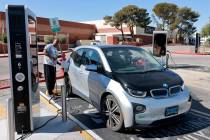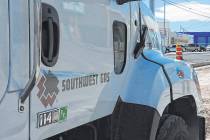Electric vehicles could lower electricity bills
Can your electric car save your family money on your home's air conditioning bill during the summer?
One interesting potential application for electric cars in the future expands their application beyond transportation chores and their money-saving capability beyond just the price of gas.
Electric cars, with their banks of mobile storage batteries, can also be an integral part of a home power system. When household vehicles are charged from a home's electrical power outlets, they are also individually connected to a regional electric utility grid. If this regional grid is converted into a smart two-way system where each home can provide power to the utility grid as well as receive it, each household can help the production and distribution of electricity within the overall infrastructure.
Vehicle-to-Grid, or "V2G," was a concept first proposed and developed by the Energy Power Research Institute in the 1990s that would make household electric cars a holistic part of a family's home electrical energy environment and its regional electric utility grid.
Think of an electric car as a mobile energy storage system where the electricity stored in the battery banks can be resold back to a utility company during peak periods of demand, such as during during hot Las Vegas summer days. Each household could purchase the electricity for its mobile battery storage bank during cheaper nonpeak hours when the utility grid would have excessive capacity, such as late evenings or early mornings of each day. This also coincides with the ideal time for recharging an electric vehicle when a family is sleeping at night. In the morning, the EV would be topped off and ready to drive.
The overall regional utility grid would benefit from this system by more evenly balancing and regulating the distribution of electricity produced by its power generation plants, potentially resulting in lower costs to all-electric utility users. In electric utility grid jargon, "peak shaving" is the practice of pulling in extra energy to the grid beyond its normal power generation capabilities during periods of peak demand. "Valley filling" is the practice of off-loading extra energy produced during periods of excess production and low demand. The electrons circulating through the transmission lines and transformers of a regional electric utility grid need to be sourced or stored somewhere during shifting high and low demand periods. The ability of a smart electrical utility grid to quickly react to sudden shifts in demand can prevent devastating blackouts, as well as efficiently distribute excess electrical power that would normally be wasted and unconsumed.
If each home was also outfitted with a five-kilowatt photovoltaic solar power panel array on its roof or backyard pedestal, each family might also have the capability to own a micropower generation plant for the regional utility. Each household could be a net provider as well as a net consumer of electricity that could be stored in an electric car battery bank when not needed by the regional grid.
NV Energy already has in place some beginning infrastructure to show how such a system might work in the future through its Cool Share Program. Participants in this program have the option of relinquishing some control of their air conditioning thermostat temperature settings to NV Energy during the summer in exchange for lower monthly air conditioning bills. During peak demand periods, NV Energy will remotely cycle the thermostat settings for each of its Cool Share Program clients. Participants will notice their thermostat settings moving gradually higher during the late morning and afternoon until peak demand to the grid starts to recede. NV Energy will then cycle the thermostat settings back down to their beginning temperature settings.
If the Cool Share Program catches on, perhaps we're on our way to V2G.
For more information on the Cool Share Program, go to www.CoolShareProgram.com or call NV Energy at 402-1111.
Stan Hanel has worked in the electronics industry for more than 30 years and is a long-time member of the Electric Auto Association and the Las Vegas Electric Vehicle Association. Hanel writes and edits for EAA's "Current Events" and LVEVA's "Watts Happening" newletters. Contact him at stanhanel@aol.com.






















